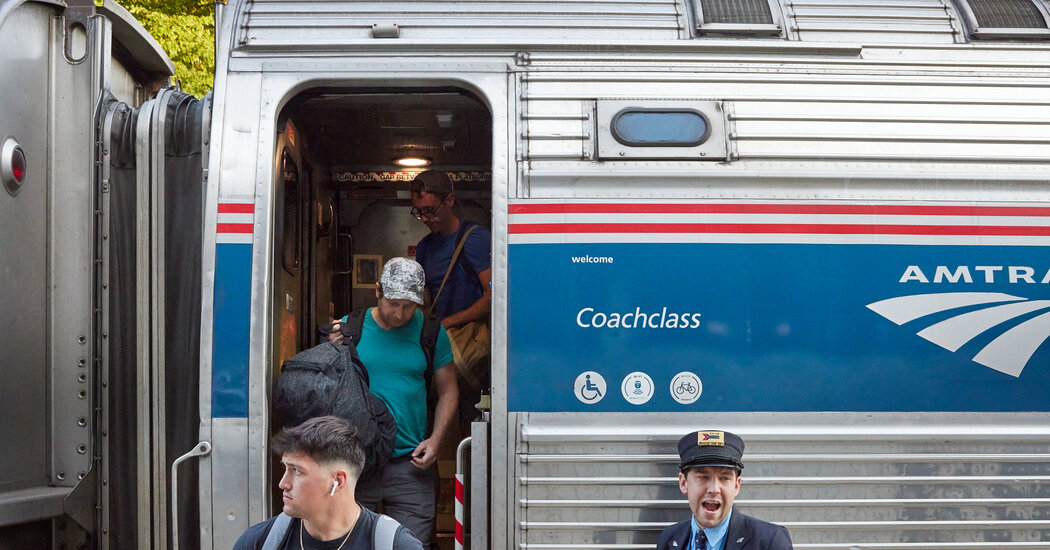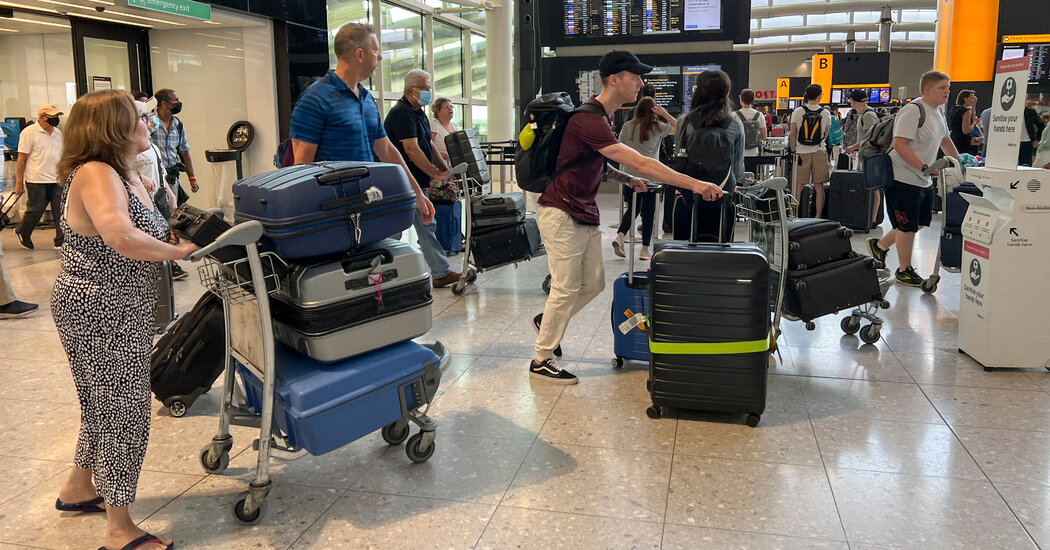
Evan Gottesman and his fiancée, Gabrielle Kleyner, were meeting friends in the Berkshires one weekend in early July. The couple, who live in Brooklyn, were trying to figure out how they would get to the rural region of western Massachusetts, which annually draws thousands of hikers, theater lovers and music aficionados with its mountains, lakes and myriad cultural centers.
A friend told them about the Berkshire Flyer, a new Amtrak train between New York City and Pittsfield. The couple quickly booked tickets and jumped on the 3:15 p.m. sold-out train from the Moynihan Train Hall in Manhattan on July 8.
Without realizing it, they had stepped onto the Flyer’s maiden voyage, a milestone at least four years in the making and the result of countless emails, meetings and phone calls between Amtrak and state legislators and transportation officials, who have been eager for more direct rail lines between New York and Massachusetts.
When Mr. Gottesman and Ms. Kleyner arrived in Pittsfield that evening, they saw dozens of people on the platform, cheering wildly and snapping pictures. State and city officials held a triumphant news conference. Someone popped a bottle of champagne.
“It was the nicest welcome I’d ever gotten stepping off an Amtrak train,” Mr. Gottesman, 27, said.
For the first time in 50 years, a passenger train from New York had arrived in Pittsfield, a city of more than 40,000 people that is often overlooked by tourists going to better-known parts of the county like Tanglewood in Lenox, the summer home of the Boston Symphony Orchestra, or the Massachusetts Museum of Contemporary Art in North Adams.
More than 60 people arrived that evening on the Berkshire Flyer, which runs only once on Friday and returns Sunday afternoon. The number of passengers was modest but it still encouraged business owners and state officials who are closely watching the pilot program, which will run through Labor Day.
Also encouraging: the number of sold-out trains. After the inaugural journey, trains to Pittsfield continued to fill up regularly, and while northern-bound seats remain available in August, trains back to New York have a limited number of tickets, with some sold out through Labor Day weekend, according to Amtrak. Travelers should check back to see if seats have opened up since there may be cancellations.
“It’s in the beginning stages,” said Lindsey Tuller, 42, a co-owner of the Berkshire General Store in Pittsfield, about two blocks from the train station. “But I think it could be a big deal.”
It “starts with local interest”
The Flyer is one of many new services and restored rail lines that Amtrak has announced in recent months.
On July 29, the Ethan Allen Express, a rail line from New York to Rutland, Vt., will be extended 66 miles northwest to the city of Burlington as part of another new program.
In Virginia, Amtrak has added more daily rides from Roanoke and Norfolk to Washington.
International routes that were shut down because of the pandemic are humming again, including the Maple Leaf train between New York and Toronto and the Cascades train between Seattle and Vancouver, which resumes in September.
In Jacksonville, N.C., a $10 million bus depot opened in June to take passengers about 84 miles north to an Amtrak station in Wilson.
Exploring America’s National Parks
The glories of the U.S. national park system draw hundreds of millions of visitors each year.
The project, which Jacksonville officials have been planning since 2010, was funded by the Federal Transit Administration, said Anthony Prinz, the city’s transportation services director.
Similar projects would be funded by the bipartisan infrastructure bill that President Biden signed into law last year, particularly in states and communities that have begun planning already, said Roger Harris, the president of Amtrak.
“It really starts with local interest,” Mr. Harris said. “That’s why it’s important for local communities to get on their game and say, ‘Yes, please, we want to get in on this.’”
Amtrak has created an expansive map that lays out a vision for how it could bring dozens more routes to more than 160 cities and towns across the country.
The new law, which sets aside $66 billion for rail, comes at a time when travelers are looking for ways to save on fuel costs and get around the country more sustainably.
The funding also comes as Amtrak continues to recover from a decline in ridership caused by the pandemic. The rail service recorded nearly 16 million rides between October 2021 and June 2022, compared with about 24 million during the same time period in 2019, according to Amtrak.
Nearly 20 percent, or $12 billion, of the total rail funding is set aside for service outside of the Northeast, giving cities and towns that want to be part of the proposed expansion a big boost, according to Amtrak officials.
North Carolina already has plans in place.
Its goal over the next decade is to work with Virginia to build a new 110-mile, one-hour train route, and draw millions of people away from congested highways, said Jason Orthner, the rail division director in North Carolina’s Department of Transportation.
“It’s definitely a different picture of life from the train than it is looking at it through the windshield on a multilane freeway,” Mr. Orthner said.
“As beautiful as I expected”
The Berkshire Flyer did not need new infrastructure, only an Amtrak train that would roll from Albany to Pittsfield (typically about a one-hour ride) and an agreement with CSX, the freight operator that owns the rail lines.
These tracks from New York to Pittsfield have existed since the 1850s, when passenger and freight trains were operated by private companies, said Jay Green, a former Amtrak official who is now the town administrator in Adams, Mass.
But as cars and planes took over as the country’s preferred modes of transportation, trains became less profitable.
Amtrak, the federally subsidized passenger train system, was created in 1971.
“That was the end of passenger traffic to Pittsfield, along with many other cities across the country,” Mr. Green said.
The sight of people spilling onto the Pittsfield platform on July 8, many of them in their 20s and 30s, prompted Adam G. Hinds, a state senator from Pittsfield, to imagine the Flyer becoming a year-round service.
One of those young people, Kareem Wedderburn, a regional planning student at Westfield State University in Massachusetts and self-described transit nerd, had taken an early morning train from Springfield, Mass., to New York on Friday morning to ensure he would be on the first Berkshire Flyer train.
“I wanted to be part of history,” said Mr. Wedderburn, 20, adding that he marveled at the scenery along the way: the Hudson River, the rolling hills, the expansive homes.
“It really is as beautiful as I expected,” he said, recalling that other passengers opened chilled bottles of white wine in the business-class car while others were reading or working on their computers.
Some stared out at the window at the drivers inching along the highway.
“People were like, ‘Look at all that traffic you can avoid now,’” Mr. Wedderburn said.
Potential for transformation
John Riley, the manager of Mission, a restaurant and bar in Pittsfield, said a steady flow of tourists would be a boon to the city’s eclectic mix of antique shops, coffee shops and restaurants.
“The biggest thing the Flyer could do, not just for us, but anybody, is more foot traffic and more people to downtown North Street,” Mr. Riley, 29, said. “I want to see more younger people, more people using the bike path.”
Ms. Tuller, the co-owner of the Berkshire General Store, said the train could help other parts of the local economy.
“I know people who have tried to be Uber drivers in the area but there weren’t enough calls to make it worthwhile,” she said.
The Flyer may encourage New Yorkers who can work remotely to move to western Massachusetts, said Eric Lesser, a state senator who represents the neighboring Hampden and Hampshire counties.
Its success could also invigorate plans for a train between Boston and Pittsfield known as the East-West line, which would stop along other postindustrial, walkable towns in western Massachusetts that were once passenger railway stops and are hungry for tourist dollars.
“They’re ripe for a renaissance,” Mr. Lesser said. “There is immense potential.”




